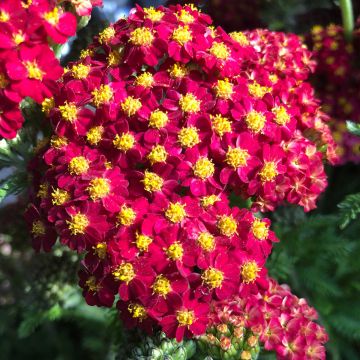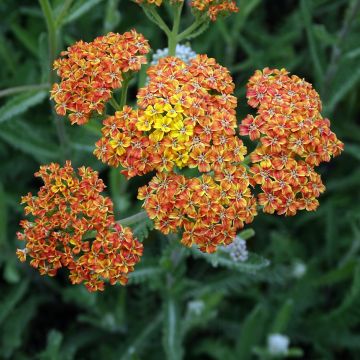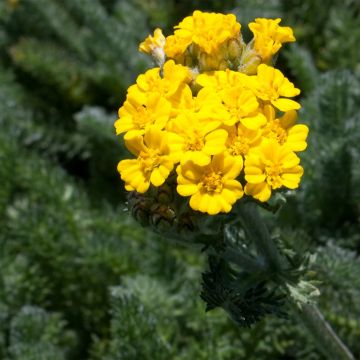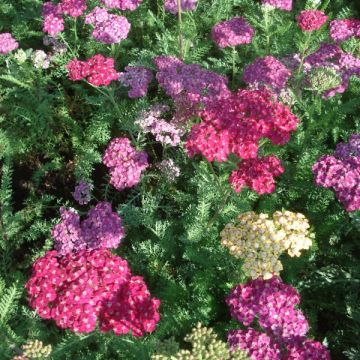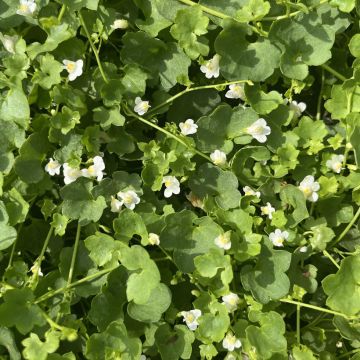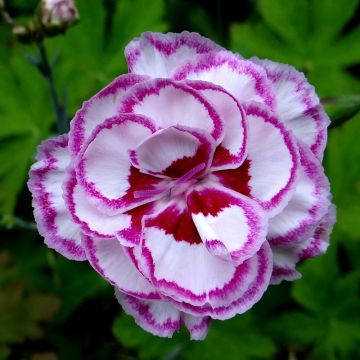

Achillea millefolium Laura
Achillea millefolium Laura
Achillea millefolium Laura
Common Yarrow, Milfoil, Thousand-leaf, Nosebleed plant
Why not try an alternative variety in stock?
View all →This plant carries a 12 months recovery warranty
More information
We guarantee the quality of our plants for a full growing cycle, and will replace at our expense any plant that fails to recover under normal climatic and planting conditions.
From €5.90 for pickup delivery and €6.90 for home delivery
Express home delivery from €8.90.
Does this plant fit my garden?
Set up your Plantfit profile →
Description
The Achillea millefolium 'Laura', also known as Yarrow, is a recent Dutch selection that stands out for its compact habit and abundant flowering. It offers bright ruby red flowers, enhanced by a small white center. This vigorous perennial plant blooms profusely throughout the summer, with very dense corymbs composed of numerous tiny flowers. Its deciduous or semi-evergreen foliage is light, feathery, and silvery green, and it remains intensely fragrant even when dried. Exuberant and undemanding, this variety will bring a cheerful touch to dried or fresh bouquets and sunny flower beds, even in dry soil. It is easy to cultivate in all regions.
Achillea millefolium 'Laura' is a perennial plant with evergreen leaves, spreading by stolons, and forming compact tufts from spring onwards. It belongs to the Asteraceae family. It is one of the many cultivars of Achillea millefolium native to Europe and Asia Minor. The plant will not exceed 40 cm (16in) in height when in flower, with foliage reaching 15 to 20 cm (6 to 8in). It spreads over 50 cm (20in) or more.
The inflorescence is a flattened corymb. The remarkably long flowering period extends from June to September. The flowers are actually heads, with tubular and white disc florets, while the peripheral florets are ligulate and ruby red. These heads, which appear at the top of the stems, form flat or slightly domed corymbs, measuring 5 to 7 cm (2 to 3in) in diameter. They give rise to fruits called achenes. The stem is channelled and villous. The foliage is deciduous or semi-evergreen, highly aromatic even when dry, and finely divided into strips. The leaves are bipinnately lobed, feathery, and dark green with silvery reflections.
Exuberant and undemanding, this old-fashioned garden inhabitant brings charm to unpretentious flower beds. Achillea millefolium 'Laura' will integrate well in rock gardens, atop a wall, as a border, or on a slope where it will help stabilize and protect against erosion. This stoloniferous plant can also be used as ground cover over large areas, allowing you to dispense with the necessary mowing for a lawn in less trafficked zones. It tolerates root competition from trees, making it a good ground cover in woodland edges as well. As this plant is easy to cultivate and tolerates drought well, it is perfect for dressing the base of shrub roses or for bordering a sunny flower bed.
According to Pliny, a Roman naturalist from the first century AD, its name comes from Achilles, a hero from Greek mythology who used it to heal wounds. Achilles allegedly discovered the healing power of this plant during the Trojan War, when he treated a wound following the advice of Venus.
In fact, the plant has recognized medicinal properties: it is hemostatic, the leaves have healing properties, and the flowers have a stimulating, tonic, and febrifuge action.
Report an error about the product description
Achillea millefolium Laura in pictures


Flowering
Foliage
Plant habit
Botanical data
Achillea
millefolium
Laura
Asteraceae
Common Yarrow, Milfoil, Thousand-leaf, Nosebleed plant
Cultivar or hybrid
Other Achillea
Planting and care
The Achillea millefolium 'Laura' can be planted all year round in buckets, about 5 feet apart per square meter, in well-worked and well-draining soil. It will grow in any type of soil, even limestone, dry or moist, as long as it is well-drained. It can even adapt to clayey soils, if they are healthy and well amended. It will grow in partial shade but prefers full sun. Remove faded flowers and cut back all vegetation at the end of the season to encourage the growth of young shoots in spring. Divide the clump in spring.
Planting period
Intended location
Care
This item has not been reviewed yet - be the first to leave a review about it.
Summer flowering perennials
Haven't found what you were looking for?
Hardiness is the lowest winter temperature a plant can endure without suffering serious damage or even dying. However, hardiness is affected by location (a sheltered area, such as a patio), protection (winter cover) and soil type (hardiness is improved by well-drained soil).

Photo Sharing Terms & Conditions
In order to encourage gardeners to interact and share their experiences, Promesse de fleurs offers various media enabling content to be uploaded onto its Site - in particular via the ‘Photo sharing’ module.
The User agrees to refrain from:
- Posting any content that is illegal, prejudicial, insulting, racist, inciteful to hatred, revisionist, contrary to public decency, that infringes on privacy or on the privacy rights of third parties, in particular the publicity rights of persons and goods, intellectual property rights, or the right to privacy.
- Submitting content on behalf of a third party;
- Impersonate the identity of a third party and/or publish any personal information about a third party;
In general, the User undertakes to refrain from any unethical behaviour.
All Content (in particular text, comments, files, images, photos, videos, creative works, etc.), which may be subject to property or intellectual property rights, image or other private rights, shall remain the property of the User, subject to the limited rights granted by the terms of the licence granted by Promesse de fleurs as stated below. Users are at liberty to publish or not to publish such Content on the Site, notably via the ‘Photo Sharing’ facility, and accept that this Content shall be made public and freely accessible, notably on the Internet.
Users further acknowledge, undertake to have ,and guarantee that they hold all necessary rights and permissions to publish such material on the Site, in particular with regard to the legislation in force pertaining to any privacy, property, intellectual property, image, or contractual rights, or rights of any other nature. By publishing such Content on the Site, Users acknowledge accepting full liability as publishers of the Content within the meaning of the law, and grant Promesse de fleurs, free of charge, an inclusive, worldwide licence for the said Content for the entire duration of its publication, including all reproduction, representation, up/downloading, displaying, performing, transmission, and storage rights.
Users also grant permission for their name to be linked to the Content and accept that this link may not always be made available.
By engaging in posting material, Users consent to their Content becoming automatically accessible on the Internet, in particular on other sites and/or blogs and/or web pages of the Promesse de fleurs site, including in particular social pages and the Promesse de fleurs catalogue.
Users may secure the removal of entrusted content free of charge by issuing a simple request via our contact form.
The flowering period indicated on our website applies to countries and regions located in USDA zone 8 (France, the United Kingdom, Ireland, the Netherlands, etc.)
It will vary according to where you live:
- In zones 9 to 10 (Italy, Spain, Greece, etc.), flowering will occur about 2 to 4 weeks earlier.
- In zones 6 to 7 (Germany, Poland, Slovenia, and lower mountainous regions), flowering will be delayed by 2 to 3 weeks.
- In zone 5 (Central Europe, Scandinavia), blooming will be delayed by 3 to 5 weeks.
In temperate climates, pruning of spring-flowering shrubs (forsythia, spireas, etc.) should be done just after flowering.
Pruning of summer-flowering shrubs (Indian Lilac, Perovskia, etc.) can be done in winter or spring.
In cold regions as well as with frost-sensitive plants, avoid pruning too early when severe frosts may still occur.
The planting period indicated on our website applies to countries and regions located in USDA zone 8 (France, United Kingdom, Ireland, Netherlands).
It will vary according to where you live:
- In Mediterranean zones (Marseille, Madrid, Milan, etc.), autumn and winter are the best planting periods.
- In continental zones (Strasbourg, Munich, Vienna, etc.), delay planting by 2 to 3 weeks in spring and bring it forward by 2 to 4 weeks in autumn.
- In mountainous regions (the Alps, Pyrenees, Carpathians, etc.), it is best to plant in late spring (May-June) or late summer (August-September).
The harvesting period indicated on our website applies to countries and regions in USDA zone 8 (France, England, Ireland, the Netherlands).
In colder areas (Scandinavia, Poland, Austria...) fruit and vegetable harvests are likely to be delayed by 3-4 weeks.
In warmer areas (Italy, Spain, Greece, etc.), harvesting will probably take place earlier, depending on weather conditions.
The sowing periods indicated on our website apply to countries and regions within USDA Zone 8 (France, UK, Ireland, Netherlands).
In colder areas (Scandinavia, Poland, Austria...), delay any outdoor sowing by 3-4 weeks, or sow under glass.
In warmer climes (Italy, Spain, Greece, etc.), bring outdoor sowing forward by a few weeks.







































